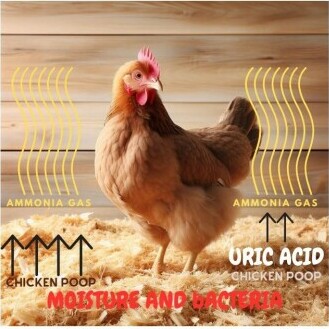
You step into your chicken coop, a place you’ve lovingly put together for your little egg-layers. Instead of the cozy home you envision, a pungent odor assaults your senses, and you notice your chickens’ once cheery eyes now teary and their breathing labored. This is the unwelcome reality of ammonia, an unseen, unheard menace lurking in many chicken coops.
Ammonia, a colorless gas with a sharp, unpleasant smell, is a byproduct of uric acid breakdown in chicken droppings. While small amounts are harmless, excessive exposure can wreak havoc on your chickens’ health. It can cause respiratory distress, eye irritation, reduced egg production, and even death.
The good news is that you don’t have to accept this unwelcome guest in your chicken’s home. With the right knowledge and a proactive approach, you can get rid of ammonia and create a healthy, odor-free environment for your feathered family to thrive in.
This comprehensive guide will explore the science behind ammonia production, look at its detrimental effects on chickens, and reveal effective strategies to prevent and control this harmful gas. We’ll transform your chicken coop into a haven of fresh air and contented, happy chickens.
The Science of Ammonia Production in Chicken Coops:
To effectively combat ammonia, it’s crucial to understand its origins and the factors that influence its production. Let’s take a scientific journey to unravel the details of ammonia generation in chicken coops.
The Role of Uric Acid and Bacterial Activity:
At the heart of ammonia production lies uric acid, a nitrogen-rich component of chicken droppings. When uric acid comes into contact with moisture and bacteria, it undergoes a process called urease hydrolysis, releasing ammonia gas.
The presence of moisture, particularly in warm and humid environments, provides the ideal conditions for bacterial growth and activity. These microorganisms thrive on the nitrogen in uric acid, accelerating the breakdown process and amplifying ammonia production.

The Impact of Poultry Manure Volume and Ventilation:
The volume of poultry manure plays a significant role in ammonia levels. A larger flock naturally produces more droppings, leading to an increased concentration of uric acid and a greater potential for ammonia formation.
Ventilation, the process of air exchange, is a critical factor in slowing or stopping ammonia buildup. Proper ventilation allows for the dilution and removal of ammonia gas, preventing it from reaching harmful concentrations.
Inadequate ventilation traps ammonia within the coop, creating an environment that endangers your chickens’ health.
Temperature and Coop Design:
Temperature plays a subtle yet influential role in ammonia production. Warmer temperatures promote bacterial growth and urease activity, leading to increased ammonia generation. On the other hand, colder temperatures slow bacterial activity, reducing ammonia production.
Coop design also influences ammonia levels. A well-designed coop with adequate ventilation openings and a raised floor promotes airflow and prevents moisture accumulation, thereby minimizing ammonia buildup.
On the flip side, a poorly ventilated coop with a solid floor traps moisture and hinders air circulation, creating an environment conducive to ammonia production.
What is the Detrimental Impact of Ammonia on Chickens?
Ammonia, a seemingly harmless gas, can have devastating consequences for your chickens. Understanding the health hazards posed by ammonia is crucial for safeguarding your chickens’ well-being.
Respiratory Distress: A Struggle for Breath:
Ammonia’s primary target is the respiratory system. As chickens inhale ammonia-laden air, the gas irritates the lining of their respiratory tract, causing inflammation and discomfort.
This can manifest as coughing, sneezing, and difficulty breathing, making it challenging for chickens to obtain the oxygen they need to thrive.
Prolonged exposure to high ammonia levels can lead to severe respiratory distress, characterized by labored breathing, gasping, and a blue tinge to the comb and wattles. In extreme cases, ammonia poisoning can result in respiratory failure and death.
Eye Irritation and Blurred Vision:
Ammonia’s caustic nature extends to its impact on the delicate eyes of chickens. When ammonia comes into contact with the eyes, it causes severe irritation, leading to redness, swelling, and excessive tear production.
This discomfort can impair chickens’ vision, making it difficult for them to navigate their surroundings and find food and water.
In severe cases, ammonia exposure can even lead to corneal ulcers and blindness.
Reduced Egg Production: A Decline in Fertility:
The detrimental effects of ammonia go beyond respiratory and eye health, impacting chickens’ reproductive capacity.
Studies have shown that exposure to elevated ammonia levels can significantly reduce egg production in laying hens.
This decline in fertility is attributed to the disruption of hormonal pathways and the suppression of ovarian function caused by ammonia poisoning.
The stress associated with ammonia exposure can also negatively impact egg quality and hatchability.
Overall Health: A Weakened Immune System:
The cumulative effects of ammonia exposure can lead to a general decline in chickens’ overall health. Prolonged exposure to this toxic gas can weaken their immune system, making them more susceptible to diseases and infections.
This weakened immune system can reveal itself as lethargy, weight loss, and feather loss. In severe cases, ammonia poisoning can even lead to death.
Preventing Ammonia Build-up: Safeguarding Your Chicken Flock
With a clear understanding of ammonia’s origins and detrimental effects, we can now work on preventing ammonia buildup in your chicken coop.
By implementing effective strategies, you can create a healthy and odor-free environment for your feathered friends to thrive in.
Regular and Thorough Coop Cleaning:
The cornerstone of ammonia control lies in regular and thorough coop cleaning.
This involves removing wet bedding, spot-cleaning droppings, and disinfecting coop surfaces. Regular cleaning prevents the accumulation of uric acid and eliminates the breeding ground for ammonia-producing bacteria.
A deep cleaning routine should be performed every 1-2 months, involving complete removal of all bedding and thorough disinfection of coop surfaces.
Be careful to wear a mask to help prevent breathing of dust, dander, and ammonia. A respirator is even better.
This deep clean helps to eliminate any lingering ammonia and ensures a fresh start for ammonia control.
Effective Bedding Management:
The choice and management of bedding play a crucial role in ammonia mitigation. Opt for absorbent bedding materials like pine shavings, shredded paper, or straw. These materials effectively trap moisture and reduce the availability of moisture for bacterial growth.
Avoid using bedding materials like cedar shavings, as they can release harmful volatile organic compounds (VOCs) that can irritate your chickens’ respiratory system.
Maintain a consistent bedding depth of 4-6 inches, as this provides adequate absorption and insulation.
Ventilation: A Fresh Air Exchange:
Ventilation is of utmost importance for preventing ammonia buildup in chicken coops. Proper ventilation allows for the dilution and removal of ammonia gas, ensuring that it does not reach harmful concentrations.
Ensure that your coop has adequate ventilation openings on all sides, allowing for cross-ventilation.
If natural ventilation is insufficient, consider installing ventilation fans or other mechanical ventilation systems to enhance air circulation.
Deep Litter Method: A Natural Ammonia Decomposer:
The deep litter method is a technique that utilizes a thick layer of bedding, typically 12-18 inches deep, to promote ammonia decomposition and reduce odor.
This method relies on the natural activity of microorganisms within the bedding to break down uric acid and convert ammonia into less harmful compounds.
To implement the deep litter method, start with a thick layer of fresh bedding and allow it to accumulate over time.
Only add new bedding as needed to maintain the desired depth. This method requires less frequent cleaning but demands careful monitoring to ensure the bedding remains dry and free of excessive moisture.
Natural Remedies for Ammonia Control: An Eco-friendly Approach
While conventional cleaning practices are essential for ammonia control, incorporating natural remedies can further enhance your efforts and create a more eco-friendly environment for your chickens.
Let’s explore some effective natural remedies for ammonia control.
Vinegar and Baking Soda Solutions: Neutralizing Ammonia Odors

Vinegar and baking soda are simple yet powerful tools for neutralizing ammonia odors and reducing gas levels in the chicken coop.
Their alkaline and acidic properties, respectively, help to counteract the alkalinity of ammonia, thereby reducing its concentration.
To use vinegar, mix one part white vinegar with four parts water and spray the solution liberally around the coop and on the bedding.
For baking soda, sprinkle the powder directly on the bedding, focusing on areas with high droppings concentration.
Diatomaceous Earth: Eliminating Pests and Controlling Bacteria
Diatomaceous earth (DE), a naturally occurring mineral composed of fossilized diatoms, is a versatile tool for chicken coop maintenance.
It offers dual benefits in ammonia control by eliminating pests and controlling ammonia-producing bacteria.
DE works by mechanically abrading pests, causing their exoskeletons to rupture and leading to dehydration and death. It also inhibits the growth of ammonia-producing bacteria, reducing the breakdown of uric acid and subsequent ammonia formation.
Something to keep in mind with diatomaceous earth is that the size of the particles are very tiny and can be more harmful to your chickens’ lungs than ammonia if too much is used. A little goes a long way.
Ammonia-absorbing Plants: A Natural Air Filtration System
Certain plants, such as spider plants, peace lilies, and snake plants, can absorb ammonia gas, improving the chicken coop’s air quality.
These plants act as natural air filters, removing ammonia from the environment and providing a healthier atmosphere for your chickens.
To utilize these plants effectively, place them in pots around the coop, ensuring they receive adequate light and water. While plants offer supplementary ammonia control, they should not replace regular cleaning and ventilation practices.
Additional Tips for Natural Ammonia Control:
- Regularly rake the bedding to aerate it and promote drying, preventing moisture buildup and bacterial growth.
- Add a layer of garden lime to the coop floor to neutralize ammonia and reduce odor.
- Ensure the coop has adequate drainage to prevent water accumulation and promote moisture removal.
- Clean and disinfect water dispensers regularly to prevent bacterial contamination and ammonia production.
Monitoring Ammonia Levels: Ensuring a Healthy Environment
Maintaining a healthy chicken coop environment requires regular monitoring of ammonia levels. By proactively assessing ammonia concentrations, you can take timely action to prevent ammonia buildup and safeguard your chickens’ well-being.

Ammonia Test Kits: A Simple and Effective Tool
Fortunately, ammonia test kits are readily available and provide a simple and effective way to measure ammonia levels in the chicken coop. These kits typically use paper strips you wet and hold in the coop air for a short time, then check the color of the test strip against a chart provided with the test kit.
There are other methods to monitor ammonia as well, including hand-held digital testers and pull tubes. To use an ammonia test kit, follow the instructions provided with the product.
Interpreting Test Results and Taking Action
The results of ammonia test kits are typically expressed in parts per million (ppm).
The acceptable range for ammonia levels in chicken coops is generally considered to be below 25 ppm. However, even lower levels are preferable to ensure optimal chicken health and egg production.
If ammonia levels exceed the acceptable range, take immediate action to address the issue. This may involve increasing ventilation, removing wet bedding, spot-cleaning droppings, or incorporating natural remedies like vinegar or baking soda.
Continuous Monitoring for Long-term Ammonia Control
While ammonia test kits provide valuable insights into ammonia levels, continuous monitoring is essential for long-term ammonia control.
This can be achieved through the use of ammonia sensors or alarms that provide real-time data on ammonia concentrations.
Ammonia sensors typically use electrochemical or optical methods to detect ammonia gas levels.
They can be connected to alarms that alert you when ammonia levels reach a predetermined threshold, allowing for prompt intervention.
Additional Tips for Effective Monitoring:
- Test ammonia levels regularly, especially during periods of warm, humid weather when ammonia production is more prevalent.
- Monitor ammonia levels in different areas of the coop to identify potential hotspots or areas requiring more attention.
- Keep a record of ammonia test results over time to track trends and identify potential issues early on.
- Consult with experienced chicken keepers or veterinarians for guidance on ammonia monitoring and control strategies.
Frequently Asked Questions: Addressing Common Concerns
As chicken lovers and guardians of their feathered friends, it’s natural to have questions about ammonia and its impact on your chicken coop. Let’s address some frequently asked questions to provide further clarity and guidance on ammonia management.
How do you effectively remove ammonia odor from the chicken coop?
Eliminating ammonia odor requires a two-pronged approach: addressing the source of ammonia production and neutralizing the existing ammonia gas.
- Source Control: Regularly clean the coop, removing wet bedding and spot-cleaning droppings. Use absorbent bedding materials like pine shavings or shredded paper. Ensure adequate ventilation to promote air circulation and ammonia dilution.
- Odor Neutralization: Apply vinegar or baking soda solutions to neutralize ammonia odors. Sprinkle diatomaceous earth on the bedding to control pests and ammonia-producing bacteria. Consider incorporating ammonia-absorbing plants like spider plants or peace lilies.
What is the Acceptable Range of Ammonia Levels for Chickens?
The acceptable range for ammonia levels in chicken coops is generally considered to be below 25 ppm (parts per million). However, even lower levels are preferable to ensure optimal chicken health and egg production.
Ammonia levels above 25 ppm can start to cause respiratory distress, eye irritation, and reduced egg production in chickens. Prolonged exposure to high ammonia levels can lead to severe health complications and even death.
Aim to clean the coop thoroughly at least once a week as a general guideline
Regular cleaning is crucial for preventing ammonia buildup in the chicken coop. The frequency of cleaning depends on factors such as the number of chickens, coop size, ventilation, and bedding type.
Aim to clean the coop thoroughly at least once a week as a general guideline for cleaning spot-cleaning. This involves removing wet bedding, spot-cleaning droppings, and disinfecting coop surfaces. For deeper cleaning, perform a complete bedding removal and coop disinfection every 1-2 months.
Monitoring ammonia levels closely and providing adequate ventilation for all chicken breeds is important
While all chicken breeds are susceptible to ammonia toxicity, some breeds may be more sensitive due to their respiratory physiology or underlying health conditions.
Breeds with smaller tracheas or compromised respiratory systems, such as Silkie chickens and other bantam breeds, may be more prone to respiratory distress from ammonia exposure.
Monitoring ammonia levels closely and providing adequate ventilation for all chicken breeds is important.
Are There Other Bedding Materials I Can Use to Help Prevent Ammonia Buildup?
Several alternative bedding materials can help reduce ammonia levels in the chicken coop:
- Pine shavings: Highly absorbent and naturally odor-controlling due to the presence of pine resin.
- Shredded paper: Absorbent and provides good insulation but may require more frequent cleaning.
- Straw: Absorbent and provides good insulation, but can be dusty and may harbor mites.
- Hemp bedding: Highly absorbent, odor-controlling, and naturally resistant to pests.
- Wood pellets: Highly absorbent and low in dust but can be more expensive than other options.

In your backyard, a haven awaits – a place where feathered friends gather, clucking and crowing, scratching and pecking. But amidst the country charm lies a hidden menace – ammonia, a silent predator lurking in the shadows of your chicken coop.
Unchecked, this gas can hurt your beloved flock, causing respiratory distress, eye irritation, reduced egg production, and even death. It’s a battle you must fight for the health and happiness of your birds.
The key to victory lies in a holistic approach, a multi-faceted strategy that combines regular cleaning, effective ventilation, and natural remedies. Remember, ammonia control is not a one-time fix but an ongoing commitment, a pledge to safeguard the well-being of your chickens.
Take proactive measures; don’t wait for the odor to alert you. Regularly test ammonia levels, monitor coop conditions, and take action at the first sign of trouble. By staying vigilant, you’ll create a safe coop free from ammonia’s suffocating grip, a place where your chickens can thrive and flourish.
Remember, knowledge is your weapon in this battle. For further guidance on ammonia management, explore the wealth of information available online and in books. Consult with experienced chicken keepers, seek advice from veterinarians, and never hesitate to reach out for help.
Together, we can transform chicken coops into happy places of fresh air and contented chickens.
Dave
Chickenmethod.com
